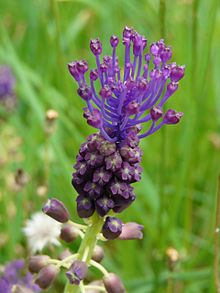- Leopoldia comosa
-
Leopoldia comosa Scientific classification 
Kingdom: Plantae clade: Angiosperms clade: Monocots Order: Asparagales Family: Asparagaceae Subfamily: Scilloideae Genus: Leopoldia Species: L. comosa Binomial name Leopoldia comosa
(L.) Parl.[1]Synonyms[1] - Hyacinthus comosus L.
- Muscari comosum (L.) Mill.
Leopoldia comosa (syn. Muscari comosum) is a perennial bulbous plant. Usually called the Tassel Hyacinth, it is one of a number of species and genera also known as Grape Hyacinths. It is found in rocky ground and cultivated areas, such as cornfields and vineyards,[2] in south-east Europe to Turkey and Iran,[3] but has naturalized elsewhere. Other common names include Tufted Grape Hyacinth, Hairy Muscari and Edible Muscari.[citation needed]
Described by Polunin as "a striking plant", it has a tuft of bright blue to violet-blue sterile flowers above brownish-green fertile flowers, which open from dark blue buds.[2] It is this tuft which gives rise to the name "Tassel Hyacinth".[3] The flower stem is 20–60 cm tall; individual flowers are borne on long stalks, purple in the case of the sterile upper flowers. Mature fertile flowers are 5–10 mm long with stalks of this length or more and are bell-shaped, opening at the mouth, where there are paler lobes. The linear leaves are 5–15 mm wide, with a central channel.[2][3]
L. comosa naturalizes easily and may become invasive. It has spread northwards from its original distribution, for example appearing in the British Isles in the sixteenth century. It is eaten in Mediterranean countries under the name cipollini, and is grown for this purpose.[citation needed]
There is a cultivar called 'Monstrosum' or 'Plumosum' in which all the flowers have become branched purple stems.[3]
Gallery
-
Lampascioni sott'olio, made from bulbs of Leopoldia comosum, is a gastronomic specialty of the Italian region of Apulia
References
- ^ a b WCSP (2011), World Checklist of Selected Plant Families, The Board of Trustees of the Royal Botanic Gardens, Kew, http://apps.kew.org/wcsp/home.do, retrieved 2011-11-14, search for "Leopoldia comosa"
- ^ a b c Polunin, Oleg (1969), Flowers of Europe : a field guide, London: Oxford University Press, ISBN 978-0-19-217621-9, p. 502 (under the name M. comosum)
- ^ a b c d Mathew, Brian (1987), The Smaller Bulbs, London: B.T. Batsford, ISBN 978-0-7134-4922-8, p. 130 (under the name M. comosum)
External links
- Wild Flowers of the British Isles: M comosum
- Paghat's Garden: M comosum
- Paghat's garden: M comosum 'Plumosum'

This Asparagales article is a stub. You can help Wikipedia by expanding it.





